
Karen Pipkin | Graceridge Rhodesian Ridgebacks
Interview with Karen Pipkin, the breeder of Graceridge Rhodesian Ridgebacks. Read about the kennel’s beginnings, the puppies, and much more.

Home » Dog Breeds » Rhodesian Ridgeback Dog Breed
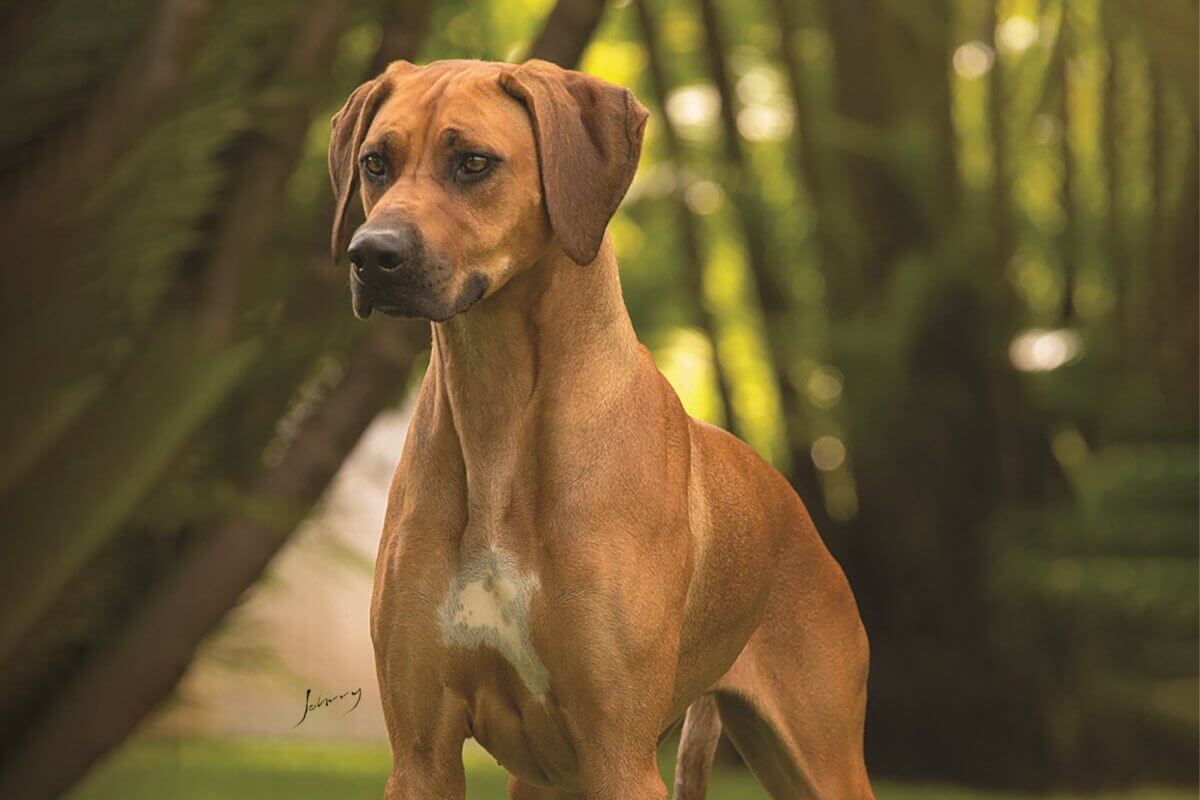
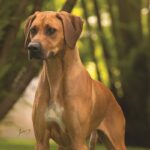
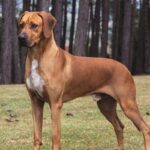
The Rhodesian Ridgeback is a very distinctive breed, renowned for the unique “ridge” of hair that runs down its back in the opposite direction to the rest of the hair. The breed originates in Southern Africa where these hounds were initially bred to track and trail large game animals, including lions, and and hold the prey at bay. This ability earned them the nickname “African Lion Hound.” The courage, agility, and resilience of these dogs made them invaluable as hunting partners, while their loyalty and protective nature assured their place as treasured household companions and defenders of the homestead.
Hound
24 – 27 Inches
70 – 85 Pounds
10 – 12 Years
| Country of Origin | Zimbabwe |
|---|---|
| Bred For | Trailing and Tracking Large Animals, Guarding, Companionship |
| Known For | Athleticism, Independence, Symmetry |
| Popularity | High |
| Temperament | Devoted, Dignified, Even-Tempered |
| Activities | Coursing, Running, Hiking, Conformation Shows, Dog Sports |
The history of the Rhodesian Ridgeback is as intriguing as its distinctive appearance. The breed’s origins can be traced back to the Khoikhoi people, the indigenous bushmen of present-day Namibia. The Khoikhoi dogs, known for their hunting prowess, were crossed with European dogs brought by early Portuguese explorers and traders in the 16th century. This fusion of breeds resulted in the creation of versatile hunting dogs that would lay the groundwork for the creation of the Rhodesian Ridgeback.
Fast-forward to the 19th century when Europeans, most notably the Boers who traced their ancestry to Dutch, German, and French Huguenots, moved into what is now Zimbabwe and South Africa. These people recognized the unique qualities of the native hunting dogs and began to breed them with the breeds they brought with them, including the Greyhound, Mastiff, and Bloodhound. Their goal was to produce a dog capable of withstanding the local environment, who that was adept at guarding their homes and aiding in the hunting of big game, most notably the lion. The dog that resulted became skilled at distracting lions and holding them at bay until the hunters arrived. This ability earned the dogs the moniker “African Lion Hound.”
The breed’s distinctive ridge of hair along its back, running in the opposite direction to the rest of the coat, became its hallmark feature. While the genetic origins of the ridge remain a subject of debate, it is believed that the Khoikhoi dogs had a role in its manifestation.
The formalization of the Breed Standard occurred in the late 1920s in Rhodesia, now Zimbabwe. Reverend Charles Helm and Francis Richard Barnes played instrumental roles in this effort, ensuring the breed retained its unique African heritage while meeting specific physical and behavioral criteria. Interestingly, the two men modeled the Ridgeback’s Standard on the that of the Dalmatian.
International recognition ultimately followed. The Rhodesian Ridgeback was officially recognized by the American Kennel Club (AKC) in 1955. Meanwhile, the Fédération Cynologique Internationale (FCI) and The Royal Kennel Club (UK) have also given their nods to this handsome and athletic breed, solidifying its place in the global canine community.
The journey of the Rhodesian Ridgeback from the savannas of Africa to show rings and homes worldwide speaks to its adaptability, resilience, and undeniable charm. Today, while it may no longer hunt lions, the breed’s regal presence and loyalty has made this upstanding hound a treasured companion for many in Africa and around the world.
Adult male Rhodesian Ridgebacks typically stand between 25 and 27 inches tall at the shoulder, with mature females being typically shorter at a height ranging from 24 to 26 inches.
When considering weight, males usually tip the scales at around 85 pounds, while females, being generally lighter, weigh in at approximately 70 pounds.
The Rhodesian Ridgeback boasts a harmonious blend of strength and speed. The breed’s proportion is just slightly longer than it is tall, providing a pleasingly symmetrical and balanced appearance. Its musculature is well-defined without being bulky, and its overall appearance is handsome, upstanding, and smooth in outline. The Ridgeback is a surprisingly quick and agile dog for its size, with a protective strength and a quickness that allows it to avoid harm.
Texture: The Rhodesian Ridgeback possesses a short, dense coat that is sleek and glossy in appearance. The coat is somewhat smooth to the touch and lies flat against the body, providing a streamlined look that suggests the breed’s fair amount of speed and its athletic prowess.
| Standard Color | |
|---|---|
| Light Wheaten | ee |
| Light Wheaten Black Nose | ee |
| Light Wheaten Brown Nose | ee |
| Red Wheaten | ee |
| Red Wheaten Black Nose | ee |
| Red Wheaten Brown Nose | ee |
| Wheaten | ee |
| Wheaten Black Nose | ee |
| Wheaten Brown Nose | ee |
| Standard Marking | |
|---|---|
| Black Mask | ee |
| White Markings | ee |
A Note About Color: The color of the Ridgeback’s coat is wheaten, in shades ranging from light to gold to red. The coat consists of banded hairs that are lighter at the base and darker at the tip. As a result, the dogs can appear to have highlights over their neck and/or shoulder blades. Ridgebacks may be clear-faced or have black on the muzzle and/or around the eyes and on the ears; however, the black should not appear as a solid mask around the eyes. Likewise, a few black hairs throughout the coat (dark brown hairs on dogs with liver-colored noses) are acceptable. White may appear on the chest and toes, although white socks are not unheard of in the breed. All other coat colors and patterns, including brindle, black brindle, black and tan, silver, and other dilute colors, are not acceptable in the breed.
The tail of the Rhodesian Ridgeback is an essential breed feature, highlighting the dog’s balanced physique and lively demeanor.
The Ridgeback’s tail is an extension of the topline and is strong at its base, tapering towards the end with a slight upward curve. In terms of its length, the tail extends down to the hocks when the dog is at rest, or it may be tucked towards the abdomen. When the Ridgeback is alert or in motion, the tail is typically elevated but does not curl over the back.
The tail’s coat remains short and dense, consistent with the body’s coat. While some Ridgebacks have a white tail tip, it is not a common characteristic for all.
The Rhodesian Ridgeback uses its tail to communicate its mood and its intentions. It is never docked. Whether wagging in happiness or used for balance during a hunt, the tail plays an essential role in the life of this active and energetic hound.
The decision to welcome a Rhodesian Ridgeback into the home is one that promises years of companionship, loyalty, and adventure. However, as with any dog, it is essential to understand the nuances of the individual’s needs and behaviors. Known for its stamina, strength, and intelligence, this African original demands attention, understanding, and commitment from its human companions.
The Rhodesian Ridgeback is a resilient and durable breed known for its hardiness. However, even with its robust nature, it can be predisposed to certain health conditions. It is important for potential owners to be informed of these concerns and to collaborate with a reputable breeder and veterinarian to provide the best healthcare for their dog throughout the years.
Lifespan: The average lifespan of a Rhodesian Ridgeback is around 10 to 12 years. With attentive care, regular veterinary visits, and a well-balanced diet, many can live a full and vibrant life, sometimes even surpassing the average typical lifespan.
The Rhodesian Ridgeback, while generally hearty, is not without its share of vulnerabilities. Some of the health issues that can affect the breed include:
Regular veterinary check-ups are paramount to diagnose and address potential health issues early on. A proactive approach to health, including routine screenings and tests recommended by a veterinarian, can help caretakers stay ahead of any health challenges in their Rhodesian Ridgeback.
The Rhodesian Ridgeback boasts a confident and dignified demeanor, embodying both courage and affection. The breed’s noble stance is complemented by a keen intelligence and an independent streak, which can sometimes be mistaken for aloofness. Beneath the poised exterior, however, lies a loyal heart and a sincerely protective nature.
For new owners, the breed’s independent nature can present a challenge. The breed’s assertiveness requires the guidance of a firm yet compassionate hand, ensuring the dog understands its position in the household.
In terms of sensitivity, Ridgebacks, while stoic at times, have a quite sensitive nature. They thrive on human companionship and can become distressed or anxious if left alone for extended periods. Building trust and a strong bond is key to having a harmonious relationship with this breed.
Loyal and affectionate with its human family, the Rhodesian Ridgeback can be reserved around strangers. The breed’s protective instinct means these dogs may take time to warm up to unfamiliar faces, but they are not naturally combative.
Generally, Ridgebacks are sociable with other dogs, especially when introduced, and socialized, from a young age. However, as with any dog, it is essential to monitor all interactions, especially if unfamiliar dogs are introduced into their territory..
The Rhodesian Ridgeback’s gentle nature with family members makes these dogs suitable companions for households with children. However, supervision is always recommended during interactions to ensure the safety of both the kids and the canine.
Feeding the Rhodesian Ridgeback requires attention to their unique dietary needs to ensure they remain vibrant and healthy. These majestic dogs have a robust build, and their diet plays a crucial role in maintaining their physique and energy levels.
For Rhodesian Ridgeback puppies, their diet should be rich in essential nutrients to support their rapid growth. High-quality puppy food, specially formulated for large breed puppies, is often recommended. This ensures they get the right balance of protein, fats, and carbohydrates to support bone and muscle development.
When transitioning to adult food, typically around 12 to 18 months of age, it’s essential to provide a well-balanced diet that caters to their energy requirements. An adult Rhodesian Ridgeback usually thrives on 2.5 to 3.5 cups of high-quality dry dog food daily, divided into two meals. However, the exact amount can vary based on the dog’s age, weight, activity level, and overall health.
When considering the amount of food, it’s also vital to take into account any additional treats or rewards given during training sessions. These should be factored into their daily caloric intake to prevent overfeeding and potential weight gain.
Regular consultations with a veterinarian can provide guidance on the nutritional needs, especially if there are concerns about weight, allergies, or other health issues. Adjustments to their diet, based on age, activity level, or health concerns, ensure they receive the nutrients they need throughout their life.
Training the Rhodesian Ridgeback can be a rewarding experience, although it does present its unique challenges due to the breed’s independent nature and intelligence. Their assertiveness and occasional stubbornness require a consistent and patient approach to training.
Rhodesian Ridgebacks are intelligent dogs with a keen sense of their surroundings. They have a natural ability to understand commands, but their independent streak may sometimes lead them to question the need to obey immediately. It’s crucial for the handler to establish themselves as the pack leader early on.
When it comes to vocalizations, Ridgebacks have a moderate tendency to bark, often alerting their human companion to unfamiliar sounds or potential threats. While this makes them excellent watchdogs, it’s essential to teach them the difference between perceived threats and everyday occurrences to prevent excessive barking.
Their intelligence can be both a blessing and a challenge. Ridgebacks are quick learners, but they can also easily pick up bad habits if not corrected early on. Positive reinforcement techniques, such as treats and praise, often yield the best results during training sessions.
Wanderlust can be a trait in Ridgebacks, owing to their history as hunting dogs in the African plains. They might have the urge to chase or explore, so it’s vital to have a secure yard and always use a leash during walks.
Predatory instincts are also present in the breed, which means they might be inclined to chase smaller animals. Early socialization and consistent training can help manage this trait, ensuring they coexist peacefully with other pets.
The Rhodesian Ridgeback, with its origins in hunting and tracking across vast African terrains, is a breed that embodies both stamina and agility. Hence, meeting their exercise needs is paramount to keep them both mentally stimulated and physically fit.
| Energy Level | Moderate |
|---|---|
| Exercise Requirements | 2 Hours/Day (Minimum), Daily Walks, Vigorous Running, Regular Exercise, Playing with Another Dog, Mental Stimulation |
The energy level of the Rhodesian Ridgeback is notably high. This breed thrives on regular, vigorous activities and benefits from a variety of exercise types. A brisk daily walk is a must, but they also appreciate opportunities to run and explore in a secure environment, such as a fenced yard or dog park.
In terms of intensity, Ridgebacks are known for their bursts of speed and endurance. Incorporating activities that challenge their agility and speed, like fetch or frisbee, can be a great way to burn off their excess energy.
Playfulness is a characteristic trait of this breed. They enjoy engaging in interactive games with their human companion and can be quite inventive in coming up with their own games when left to their devices.
However, it’s essential to monitor their exercise, especially in extreme weather conditions. Due to their short coat, they can be more susceptible to the cold, and their dark coat can make them prone to overheating in the scorching heat.
Incorporating both mental and physical stimulation in their daily routine is vital. Activities like Obedience training, Agility courses, or even Scent Tracking can keep their minds sharp and cater to their inherent traits.
Grooming a Rhodesian Ridgeback, while relatively straightforward due to their short coat, still necessitates regular attention to keep them looking and feeling their best.
| Coat Type | Short, Dense, Sleek, Glossy |
|---|---|
| Grooming Requirements | Weekly Brushing, Occasional Bathing, Routine Ear Cleaning, Periodic Nail Trimming, Regular Tooth Brushing |
The coat of the Rhodesian Ridgeback is sleek and dense, lying close to the body. One of the distinct advantages of this coat type is that it requires minimal grooming. A weekly brush with a soft bristle or rubber curry brush will suffice to remove loose hairs and maintain the coat’s natural sheen.
Another benefit of their coat is the minimal shedding. While they do shed, it’s significantly less compared to many other breeds. Regular brushing helps in managing this by capturing the loose hairs before they end up around the home.
In addition to coat care, routine checks of their ears, eyes, and teeth are essential. Their ears should be inspected weekly for signs of wax buildup, redness, or infection. Cleaning them as needed with a vet-approved cleanser can prevent potential issues.
Dental care is another crucial aspect of grooming. Brushing their teeth several times a week helps prevent tartar buildup and gum disease. If regular brushing isn’t feasible, dental chews or toys can act as alternatives, promoting dental health.
Lastly, nail care shouldn’t be overlooked. If the Ridgeback doesn’t naturally wear down their nails through regular activity, monthly trims might be necessary to prevent overgrowth and the potential issues that can arise from it.
The Rhodesian Ridgeback is a breed that exudes confidence, loyalty, and a hint of independence, making them a unique companion in any living environment. However, certain considerations should be taken into account to provide them with the best possible living conditions.
While the breed’s size and energy might suggest they’re suited only for homes with expansive yards, they can adapt to apartment living if their exercise needs are adequately met. Their relatively quiet nature indoors and a propensity to bond closely with their human companion can make them good candidates for urban living. However, a caretaker should be prepared to provide longer walks or more frequent outings to compensate for the lack of a backyard.
In terms of weather adaptability, their short coat and origins from the warm climates of southern Africa mean they favor hotter conditions. They can bask in the sun and handle warm temperatures well. However, their thin coat offers little insulation during colder months. In cold weather, especially during winter, it might be necessary to provide them with a dog sweater or jacket, and it’s crucial to limit their exposure to extremely cold temperatures.
Hot weather poses its own challenges. While the Ridgeback can handle warmth, excessive heat and direct sun can be problematic. Providing them with ample shade, fresh water, and avoiding peak heat periods for exercise can mitigate the risks associated with overheating.
The arrival of a litter of Rhodesian Ridgeback puppies is a real cause for celebration, one that is marked by the pups’ boundless energy, endearing antics, and rapid growth. The puppies, with their expressive eyes and playful nature, can quickly capture the hearts of those around them. However, it is important to remember that behind their cute demeanor lies a breed with specific needs and traits that require particular attention during their formative months.
Ensuring the health and well-being of a Rhodesian Ridgeback puppy is a multifaceted responsibility. Nutrition is at the forefront of this care. Providing high-quality puppy food, rich in essential nutrients, will support their rapid growth and development. Monitoring their eating habits and adjusting portions as they grow is vital, always consulting with a veterinarian for guidance.
Early socialization plays a significant role in shaping the Ridgeback puppy’s temperament and its behavior as an adult. Exposing the pup to various environments, people, and other animals in a controlled manner can help in building confidence and reducing potentially fearful or aggressive behavior in the future.
Training should begin at an early age. While the Ridgeback pup is undoubtedly endearing, its natural assertiveness and independence can become challenging if not addressed early on. Basic obedience training, coupled with positive reinforcement techniques, can lay the foundation for a well-behaved adult Ridgeback.
In terms of healthcare, regular veterinary check-ups are paramount during puppyhood. These initial visits will involve vaccinations, deworming, and general health assessments, ensuring the pup is on the right track for a healthy life.
Physical activity should be approached with a measure of caution. While it is tempting to engage the young Ridgeback in rigorous play, excessive or high-impact exercise can be detrimental to the developing joints and bones. Instead, moderate play and short walks can suffice until the pup has matured.
Lastly, providing a safe environment for exploration is crucial. The Rhodesian Ridgeback puppy is naturally curious and might find itself in precarious situations if left unsupervised. Securing potential hazards, offering safe toys, and puppy-proofing the living space can prevent unwanted accidents and incidents.
The Rhodesian Ridgeback, with its heritage rooted in hunting and guarding, possesses a combination of agility, endurance, and intelligence. These traits make the breed exceptionally well-suited for various activities and dog sports. Engaging in these endeavors not only provides physical stimulation, it also nurtures the bond between the Ridgeback and its handler. Some of the suitable activities for Ridgebacks include:
Engaging a Rhodesian Ridgeback in activities and dog sports not only keeps them physically and mentally stimulated but also strengthens the bond between dog and handler.
The Rhodesian Ridgeback is recognized by the world’s leading registries and kennel organizations, which categorize the breed into a specific Group based on its unique characteristics. This breed is recognized worldwide under the following Group designations:
| Organization | Group Designation |
|---|---|
| AKC (American Kennel Club) | Hound |
| UKC (United Kennel Club) | Sighthound and Pariah Dog |
| CKC (Canadian Kennel Club) | Hounds |
| ANKC (Australian National Kennel Council) | Hounds |
| RKC (The Royal Kennel Club) | Hound |
| FCI (Fédération Cynologique Internationale) | Group 6: Scent Hounds and Related Breeds; Section 3: Related Breeds |
The ideal Rhodesian Ridgeback is described by a Breed Standard that is approved by each of the world’s leading registries and kennel organizations. The Breed Standards for this breed may be found in the following links:
| Organization | Breed Standard |
|---|---|
| American Kennel Club | AKC Rhodesian Ridgeback Breed Standard |
| United Kennel Club | UKC Rhodesian Ridgeback Breed Standard |
| Canadian Kennel Club | CKC Rhodesian Ridgeback Breed Standard |
| Australian National Kennel Council | ANKC Rhodesian Ridgeback Breed Standard |
| The Royal Kennel Club | RKC Rhodesian Ridgeback Breed Standard |
| Fédération Cynologique Internationale | FCI Rhodesian Ridgeback Breed Standard |
Affiliation with breed-specific clubs serves as a testament to the dedication and passion individuals have for the Rhodesian Ridgeback. These clubs are instrumental in promoting responsible breeding, offering educational resources, organizing events, and fostering a community of enthusiasts and breeders.
In the United States, the Rhodesian Ridgeback Club of the United States (RRCUS) stands out as the premier organization dedicated to the breed. Founded in 1952, before the AKC recognition, the RRCUS has been pivotal in maintaining breed standards, offering breeder resources, and organizing national specialty shows.
In Canada, the Rhodesian Ridgeback Club of Canada (RRCC) is the go-to institution for Canadian breed enthusiasts. Similar to its US counterpart, the RRCC works diligently to promote the breed, educate the public, and provide platforms for competition and community engagement.
In the United Kingdom, the Rhodesian Ridgeback Club of Great Britain (RRCGB) is the primary organization dedicated to the breed. Established in 1952, the RRCGB plays a crucial role in safeguarding the breed’s integrity, organizing events, and offering a platform for breeders and owners to collaborate.
The commitment and dedication of breed-specific rescue groups have a profound impact on the lives of many dogs, giving them a second chance at a loving home. The Rhodesian Ridgeback, with its rich history and distinct appearance, is fortunate to have individuals and organizations devoted to its welfare.
Covering both the United States and Canada, the Rhodesian Ridgeback Rescue, Inc. stands at the forefront of rescue efforts for this breed. This organization is deeply involved in rescuing Ridgebacks that have been abandoned, mistreated, or are in distress. Beyond rescue operations, they are committed to educating potential adopters, providing invaluable resources for Ridgeback owners, and advocating for responsible ownership. Their dedication ensures that Ridgebacks, regardless of their past experiences, find a home where they are cherished and provided the care they deserve.
Established in 1994, the Rhodesian Ridgeback Welfare Trust in the United Kingdom has been steadfast in its mission to rescue and rehabilitate Ridgebacks. The organization provides essential medical care, arranges foster homes, and takes great care in ensuring that each dog is paired with the most suitable adoptive family. Through their unwavering efforts, they have played a pivotal role in enhancing the well-being of the breed within the region.
While these breed-specific groups offer specialized care and knowledge, many all-breed rescue organizations and local shelters also occasionally house Ridgebacks or Ridgeback mixes.
Rhodesian Ridgebacks do shed, but they are considered low shedders compared to many other breeds. Their short and dense coat requires minimal grooming, but regular brushing can help to reduce the hair that is lost and will keep the coat looking its best.
The typical lifespan of a Rhodesian Ridgeback is between 10 and 12 years. With proper care, a balanced diet, and regular veterinary check-ups, some Ridgebacks can live beyond this range, enjoying good health and vitality in their senior years.
Like many breeds, Rhodesian Ridgebacks can be prone to certain health conditions. Common causes of mortality include cancer, cardiac issues, and hip dysplasia. However, with regular veterinary care and early detection, many conditions can be managed or treated successfully.
Rhodesian Ridgebacks are not inherently aggressive. They are, however, confident and protective, which can sometimes be misconstrued as aggression. Proper socialization and training from a young age are essential to ensure these hounds are well-behaved and approachable.
Yes, Rhodesian Ridgebacks are intelligent dogs. They are quick learners, but their independent nature can sometimes be mistaken for stubbornness. Consistent training and positive reinforcement methods work best with this active and intelligent breed.
Individual preferences can vary, but in general, Rhodesian Ridgebacks do not enjoy water and swimming. Although their short coat dries quickly, making them suitable candidates for water-related activities, it is always essential to introduce a Ridgeback to water gradually to assess the dog’s reaction.
Rhodesian Ridgebacks can make excellent family dogs. They are well-known for their loyalty and affection towards their human family members. And with early socialization they can get along well with children and other pets, although all interactions should be monitored for safety.
Male Rhodesian Ridgebacks typically weigh around 85 pounds and stand about 25–27 inches tall at the shoulder. Females are slightly smaller, usually weighing around 70 pounds, and standing 24-26 inches tall.
Rhodesian Ridgebacks were historically bred in Southern Africa for assisting hunters, specifically to track large game such as antelope and lion. This earned the dog the nickname “African Lion Hound.” The Ridgeback’s agility, bravery, and stamina made it invaluable for the role.
Yes, Rhodesian Ridgebacks can make effective guard dogs. The breed’s protective nature, combined with its deep bark, can reliably deter potential intruders. However, it is crucial to provide these dogs with proper training to ensure they can differentiate between genuine threats and benign situations.
No, Rhodesian Ridgebacks are not considered hypoallergenic. While they are low shedders, they still produce dander, which can trigger allergies in sensitive individuals, and their saliva can be an irritant for people with skin sensitivities.
The characteristic ridge of hair running in the opposite direction on the dog’s back is a unique trait that is believed to have originated from the indigenous Khoikhoi dog. This ridge became a defining feature of the breed and is one of the elements breeders look for in show-quality dogs. Interesting, a few Ridgebacks can be born without the ridge.

Interview with Karen Pipkin, the breeder of Graceridge Rhodesian Ridgebacks. Read about the kennel’s beginnings, the puppies, and much more.
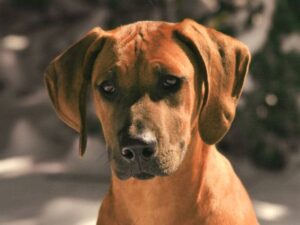
Learn about the Ridgeback breed standard and key attributes for show dogs. Discover what makes a typical, sound Ridgeback.
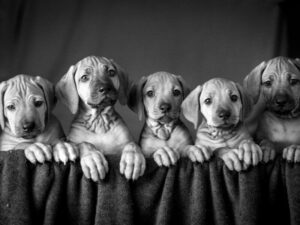
Discover the Rhodesian Ridgeback breed’s history, characteristics, and suitability as a pet in this informative article.
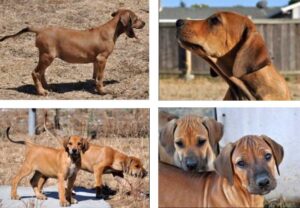
Robert Russell is the breeder behind Parnassus Rhodesian Ridgebacks. Read about the kennel’s beginnings, the dogs, the puppies, and more!
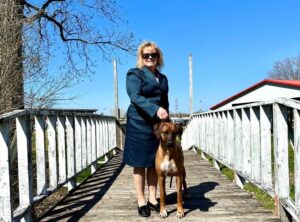
Tammy Lynch is the breeder behind Adili Rhodesian Ridgebacks. Read about the kennel’s beginnings, the sires, the dams, the puppies, and more!
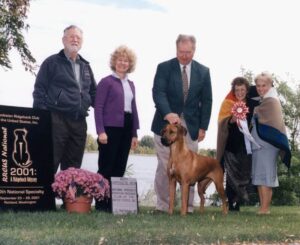
Clayton Heathcock is the breeder of Camelot Rhodesian Ridgebacks. Read about the kennel’s beginnings, the champions, the puppies, and more!

Deb Ahern-Ridlon is the breeder behind Adwera Rhodesian Ridgebacks. Read about the kennel’s beginnings, the champions, the puppies, and more!
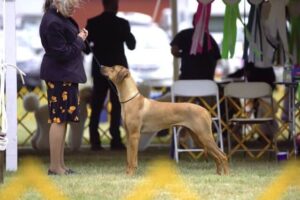
Interview with purebred Rhodesian Ridgeback Breeder/Owner Handler – My name is Deborah Ahern-Ridlon and my kennel name is ADWERA.

Dan Sayers is the Editor-in-Chief of SHOWSIGHT digital and print publications. He received a B.S. from Drexel University where he studied interior architectural design. His professional career has allowed him to develop his planning, problem-solving, and project management skills, which were employed in the office, educational, and financial sectors. While working as a project manager, he earned a Graphic Design Certificate from the University of the Arts and began creating ads for many of America’s top-winning show dogs. Through this work, Dan became Editor-in-Chief of the nation’s first online-only dog show publication. His current role expands on this experience and broadly extends to cover the sport of dogs in Companion and Performance events as well as all aspects of Conformation.
Dan is a long-time member of the Irish Water Spaniel Club of America and is the organization’s current AKC Delegate and Archivist/Historian, as well as a club-approved Breed Mentor. From 2000-2010, he was the club’s AKC Gazette Columnist. He breeds Irish Water Spaniels under the Quiet Storm prefix and has judged the IWSCA National Specialty Sweepstakes twice. Dan is a member of the Morris and Essex Kennel Club as well as the Dog Writers Association of America, which recognized his illustrations in the award-winning canine compendium, the Encyclopedia of K-9 Terminology.
The best way to ensure a long and happy relationship with a purebred dog is to purchase one from a responsible breeder. Not sure where to begin?
Contact the National Parent Club’s Breeder Referral Program, which is listed on the AKC Breeder Referral Contacts page.
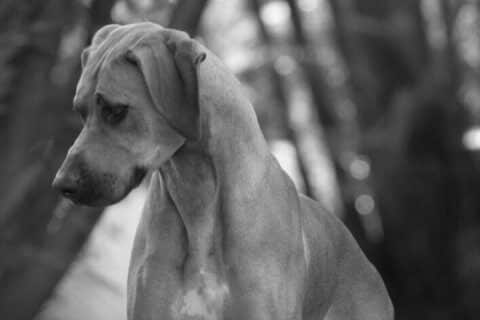

"*" indicates required fields
Showsight Magazine–the world’s most influential purebred dog publication since 1992. Each issue reaches a global audience dedicated to preserving the history and health of purpose bred dogs. Filled with award-winning editorial focused on news and insights from the dog show community, top breeders, handlers, AKC Judges, and more!